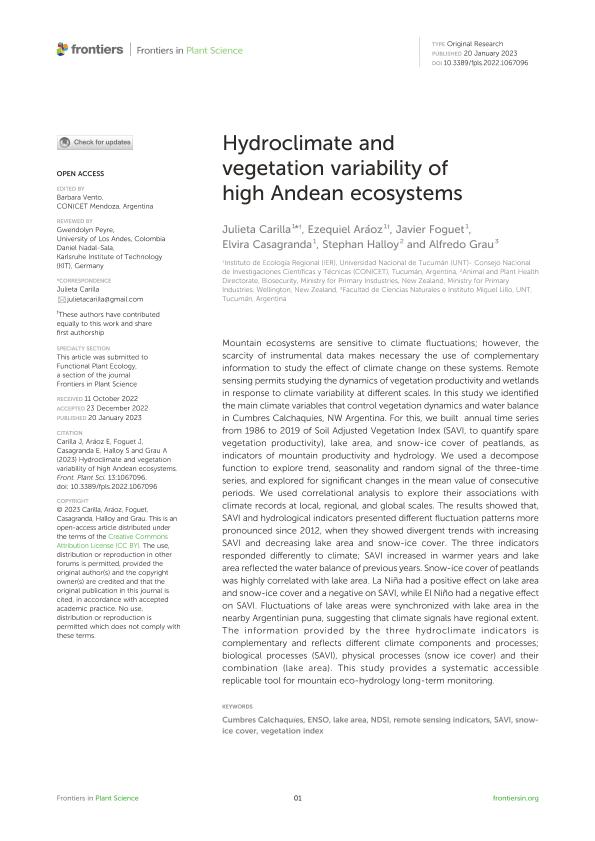Mostrar el registro sencillo del ítem
dc.contributor.author
Carilla, Julieta

dc.contributor.author
Aráoz, Ezequiel

dc.contributor.author
Foguet, Javier

dc.contributor.author
Casagranda, Maria Elvira

dc.contributor.author
Halloy, Stephan

dc.contributor.author
Grau, Alfredo

dc.date.available
2024-04-16T10:57:26Z
dc.date.issued
2023-01
dc.identifier.citation
Carilla, Julieta; Aráoz, Ezequiel; Foguet, Javier; Casagranda, Maria Elvira; Halloy, Stephan; et al.; Hydroclimate and vegetation variability of high Andean ecosystems; Frontiers Media; Frontiers in Plant Science; 13; 1-2023; 1-16
dc.identifier.issn
1664-462X
dc.identifier.uri
http://hdl.handle.net/11336/233111
dc.description.abstract
Mountain ecosystems are sensitive to climate fluctuations; however, the scarcity of instrumental data makes necessary the use of complementary information to study the effect of climate change on these systems. Remote sensing permits studying the dynamics of vegetation productivity and wetlands in response to climate variability at different scales. In this study we identified the main climate variables that control vegetation dynamics and water balance in Cumbres Calchaquíes, NW Argentina. For this, we built annual time series from 1986 to 2019 of Soil Adjusted Vegetation Index (SAVI, to quantify spare vegetation productivity), lake area, and snow-ice cover of peatlands, as indicators of mountain productivity and hydrology. We used a decompose function to explore trend, seasonality and random signal of the three-time series, and explored for significant changes in the mean value of consecutive periods. We used correlational analysis to explore their associations with climate records at local, regional, and global scales. The results showed that, SAVI and hydrological indicators presented different fluctuation patterns more pronounced since 2012, when they showed divergent trends with increasing SAVI and decreasing lake area and snow-ice cover. The three indicators responded differently to climate; SAVI increased in warmer years and lake area reflected the water balance of previous years. Snow-ice cover of peatlands was highly correlated with lake area. La Niña had a positive effect on lake area and snow-ice cover and a negative on SAVI, while El Niño had a negative effect on SAVI. Fluctuations of lake areas were synchronized with lake area in the nearby Argentinian puna, suggesting that climate signals have regional extent. The information provided by the three hydroclimate indicators is complementary and reflects different climate components and processes; biological processes (SAVI), physical processes (snow ice cover) and their combination (lake area). This study provides a systematic accessible replicable tool for mountain eco-hydrology long-term monitoring.
dc.format
application/pdf
dc.language.iso
eng
dc.publisher
Frontiers Media

dc.rights
info:eu-repo/semantics/openAccess
dc.rights.uri
https://creativecommons.org/licenses/by-nc-sa/2.5/ar/
dc.subject
CUMBRES CALCHAQUÍES
dc.subject
ENSO
dc.subject
LAKE AREA
dc.subject
NDSI
dc.subject
REMOTE SENSING INDICATORS
dc.subject
SAVI
dc.subject
SNOW-ICE COVER
dc.subject
VEGETATION INDEX
dc.subject.classification
Ecología

dc.subject.classification
Ciencias Biológicas

dc.subject.classification
CIENCIAS NATURALES Y EXACTAS

dc.title
Hydroclimate and vegetation variability of high Andean ecosystems
dc.type
info:eu-repo/semantics/article
dc.type
info:ar-repo/semantics/artículo
dc.type
info:eu-repo/semantics/publishedVersion
dc.date.updated
2024-04-12T13:16:35Z
dc.journal.volume
13
dc.journal.pagination
1-16
dc.journal.pais
Suiza

dc.journal.ciudad
Lausanne
dc.description.fil
Fil: Carilla, Julieta. Universidad Nacional de Tucumán. Instituto de Ecología Regional. Consejo Nacional de Investigaciones Científicas y Técnicas. Centro Científico Tecnológico Conicet - Tucumán. Instituto de Ecología Regional; Argentina
dc.description.fil
Fil: Aráoz, Ezequiel. Universidad Nacional de Tucumán. Instituto de Ecología Regional. Consejo Nacional de Investigaciones Científicas y Técnicas. Centro Científico Tecnológico Conicet - Tucumán. Instituto de Ecología Regional; Argentina
dc.description.fil
Fil: Foguet, Javier. Universidad Nacional de Tucumán. Instituto de Ecología Regional. Consejo Nacional de Investigaciones Científicas y Técnicas. Centro Científico Tecnológico Conicet - Tucumán. Instituto de Ecología Regional; Argentina
dc.description.fil
Fil: Casagranda, Maria Elvira. Universidad Nacional de Tucumán. Instituto de Ecología Regional. Consejo Nacional de Investigaciones Científicas y Técnicas. Centro Científico Tecnológico Conicet - Tucumán. Instituto de Ecología Regional; Argentina
dc.description.fil
Fil: Halloy, Stephan. No especifíca;
dc.description.fil
Fil: Grau, Alfredo. Universidad Nacional de Tucumán. Facultad de Ciencias Naturales e Instituto Miguel Lillo; Argentina
dc.journal.title
Frontiers in Plant Science
dc.relation.alternativeid
info:eu-repo/semantics/altIdentifier/doi/http://dx.doi.org/10.3389/fpls.2022.1067096
Archivos asociados
